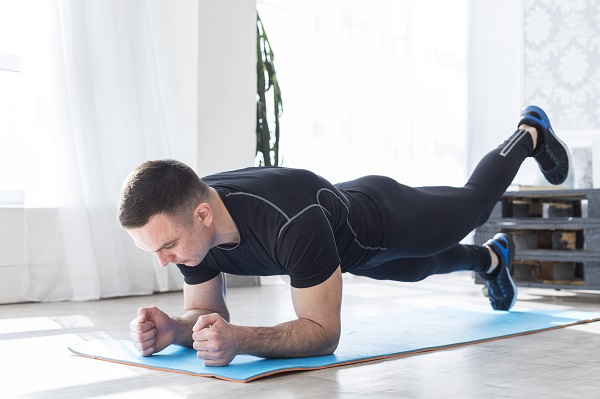Who says muscles are only made in the gym? They can be made at home with simple bodyweight exercises. Yes, you read that right.
Up until now, we had believed that lifting several kilos of dumbbells and adequate protein intake can build muscles. While there is no denying that protein is essential, dumbbells are not. You have your natural weight with you – and that is your body mass. So, you might as well ditch the excuse you tell yourself that you don’t have a good gym near you. You have the gym you need with you – your body weight.
This is not to say that they’re better than dumbbells, but pretty useful if you use your body weight strategically. This includes challenging your body with every rep.
We’ll be telling how bodyweight exercises can help your overall fitness by adding muscles. Let’s get started, shall we?
How do bodyweight exercises work?
First things first, you must be surprised to find out that bodyweight exercises do work. So, to give you some clarity, you must know that bodyweight exercises involve a lot of pulling, pushing and jumping. It basically involves activities that require you to use your own body weight as resistance. You’d be surprised to know that even the smallest changes you make to those postures, such as moving hands or increasing sets or reps can make a workout challenging. And remember, muscles are only built when they are challenged.
How do muscles grow?
Before discussing bodyweight exercises specifically, it’s essential to understand how muscles grow in the first place. Muscle growth, also known as hypertrophy, occurs when the muscle fibres undergo stress and then repair themselves, becoming thicker and stronger. This process is typically triggered through resistance or strength training, where muscles are forced to work harder than usual, causing tiny tears in the muscle tissue. As the body repairs these microtears, muscle mass increases.
The most common method of inducing hypertrophy is through lifting weights, but the fundamental principle here is resistance, which can come from various sources – including your own body weight.
The science behind bodyweight exercises
Bodyweight exercises involve using the resistance provided by your own body to strengthen muscles. These exercises typically engage multiple muscle groups simultaneously, improving overall functional strength, flexibility, and balance. The key is that your muscles must work against a form of resistance, and bodyweight exercises can provide ample challenge if executed correctly.
Can bodyweight exercises build muscle?
Yes, bodyweight exercises can build muscle, but it largely depends on how you perform them and your consistency. To grow muscles, the primary factors are intensity, volume, and progressive overload. Let’s break these down:
Intensity:
You need to challenge your muscles to create the microtears necessary for growth. Many people mistakenly assume that bodyweight exercises lack the intensity needed to achieve hypertrophy. However, exercises like pull-ups or single-leg squats (pistol squats) can be incredibly demanding. The key is to push yourself to the point where your muscles are fatigued by the end of each set.
Volume:
Volume refers to the number of sets and repetitions you perform. A high volume of exercises can induce hypertrophy even without weights. By doing more reps, you increase the total time under tension for the muscle, which helps stimulate growth. For example, doing 3-4 sets of push-ups with 12-15 reps per set can help build the chest, triceps, and shoulders.
Progressive overload:
Progressive overload is the principle of gradually increasing the resistance or challenge placed on your muscles over time. With bodyweight exercises, this can be achieved by adding more reps, altering the angle of the movement (e.g., elevating your feet during push-ups), or transitioning to more advanced variations like one-arm push-ups or handstand push-ups. This continuous challenge is crucial for long-term muscle growth.
Common misconceptions
While bodyweight exercises can be highly effective, some misconceptions may lead people to believe that they can’t build significant muscle mass without weights. Here are a few:
“Bodyweight exercises are only good for toning, not building muscle”:
This is false. The idea of “toning” is simply building muscle while reducing fat. With the right intensity and volume, bodyweight exercises can build muscle just as effectively as weightlifting.
“You can’t progressively overload with bodyweight exercises”:
As mentioned earlier, progressive overload is possible with bodyweight exercises. By increasing reps, adjusting the exercise angle, or moving to more advanced variations, you can continuously challenge your muscles.
“Bodyweight exercises won’t build lower body muscles”:
While it’s true that exercises like squats may not seem as intense as lifting a loaded barbell, challenging variations like pistol squats or jump squats can be incredibly effective for building strength and muscle in your legs.
Closing thoughts
You can absolutely build muscles with bodyweight exercises if you approach them with the right intensity, volume, and progressive overload. Whether you’re a beginner or looking to supplement your weightlifting routine, bodyweight training can help your muscle-building journey. So, get started with some push-ups, squats, and pull-ups, and witness the transformation of your physique through the power of your own body.




